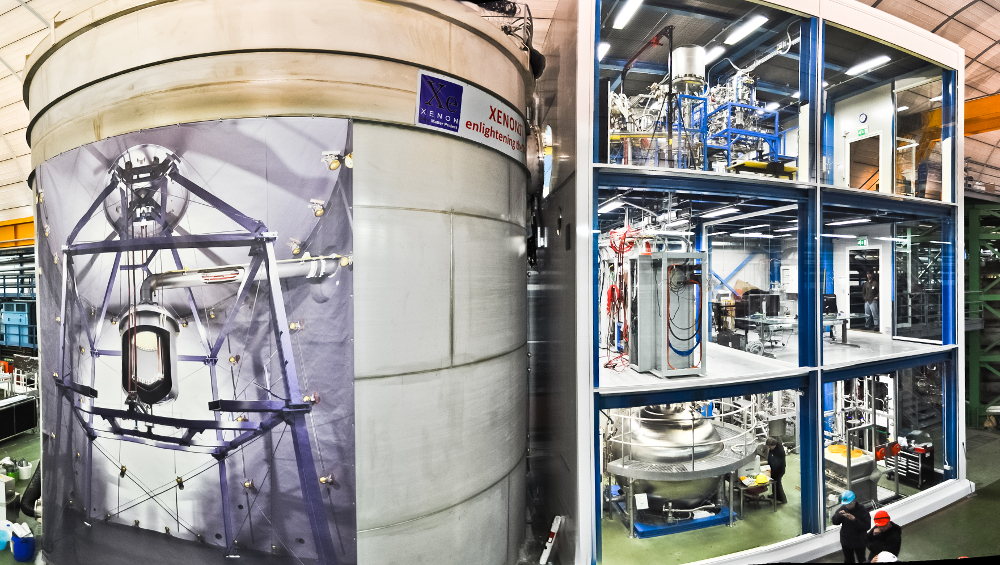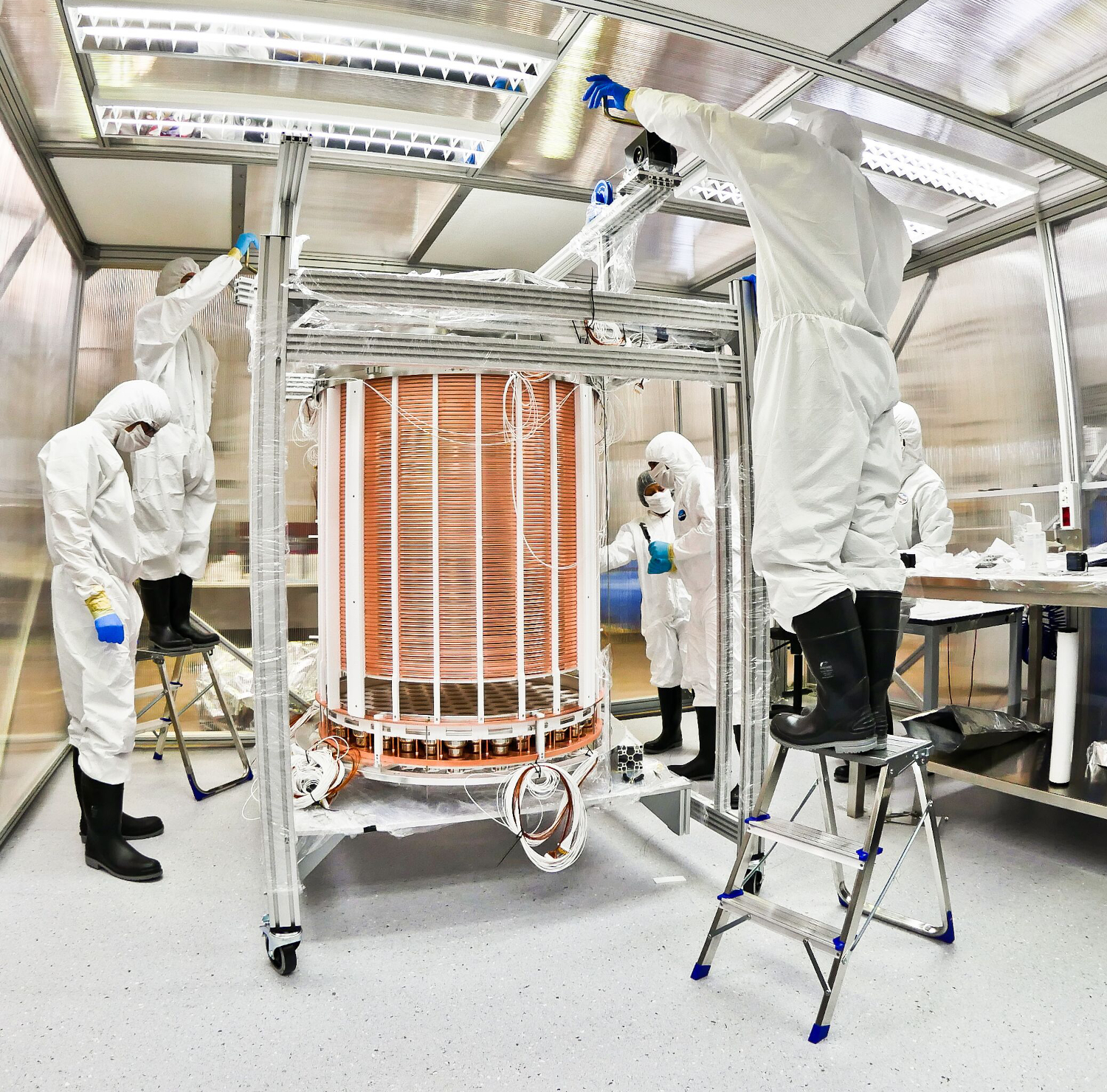Even without dark matter Xenon1T is a success
Xenon1T is the largest detector of dark matter in the world. Unveiled in 2015, it searches for this invisible material — which is five times more abundant in the universe than ordinary matter — from the Gran Sasso laboratory in Italy, buried under a mountain. In May 2017, an international collaboration of 130 scientists published the first observations made by the instrument. Dominique Thers, the coordinator of the experiment in France and a researcher at Subatech*, explains the importance of these initial results from Xenon1T. He gives us an overview of this cutting-edge research, which could unlock the secrets of the universe.
[divider style=”dashed” top=”20″ bottom=”20″]
Learn more about Xenon1T by reading our article about the experiment.
[divider style=”dashed” top=”20″ bottom=”20″]
What did the Xenon1T collaboration work on between the inauguration a year and a half ago and the first results published last month?
Dominique Thers: We spent the better part of a year organizing the validation of instruments to make sure that they worked properly. The entire collaboration worked on this qualification and calibration phase between fall 2015 and fall 2016. This phase can be quite long and it’s difficult to predict how long it will take in advance. We were very satisfied to finish it in a year — a short time for such a large-scale experiment like Xenon1T.
So you had to wait one year before launching the first real experiment?
DT: That’s right. The first observations were launched in early December 2016. We had allowed the ton of xenon to be exposed to potential dark matter particles for exactly 34.2 days. In reality, the actual time was a bit longer, since we have to recalibrate the instruments regularly and no data is recorded during these times. This period of exposure ended on January 18, when three high-magnitude earthquakes were recorded near Gran Sasso. Due to mechanical turbulence, the instruments had to be serviced over the course of a week, and we decided at that time to proceed to what we call “unblinding.”
Does that mean you only discovered what you had been recording with the experiment once it was finished, rather than in real time?
DT: Yes, this is in line with the logic of our community. We perform data analysis which is independent from its acquisition. This allows us to limit bias to the maximum in our analysis, as this could occur when we stop an observation period to verify whether or not there has been an interaction between the xenon and dark matter. When we have reached a significant period of time we determine to be satisfactory, we stop the experiment and look at the data. The analysis portion is prepared in advance and everyone is ready for this moment in general. The earthquake occurred very near to the scheduled end date, so we preferred to stop the measurements then.
The results did not reveal interactions between the xenon and dark matter particles, which would have represented a first direct observation of dark matter. Does this mean that the collaboration has been a failure?
DT: Not at all! It’s important to understand that there is fierce competition around the globe to increase the volume of ordinary material exposed to dark matter. With a ton of xenon, Xenon1T is the world’s largest experiment, and potentially, the most likely to observe dark matter. It was out of the question to continue over a long period of time without first confirming that the experiment had reached an unprecedented level of sensitivity. With this first publication, we have proven that Xenon1T is up to the challenge. However, Xenon1T will only reach its maximum sensitivity in sessions lasting 18 to 24 months, so it holds great promise.
How does this sensibility work? Is Xenon1T really more sensitive than other competing experiments?
DT: A very simple but symbolic approach is to say that the more the detector is exposed to dark matter, the more likely it is to record an interaction between it and ordinary matter. We therefore have a law proportional to time. So, it’s clear to see why, after obtaining this world record in just one month, we are optimistic about the capacities of Xenon1T over an 18 to 24-month period. But we cannot go further than this point, since we would encounter an excessive level of background noise, which would hide potential observations of dark matter with Xenon1T.

The Xenon1T experiment in the Gran Sasso laboratory in Italy. On the left, the xenon reservoir enclosed in protective casing. On the right, rooms housing instruments used for analysis and control in the experiment.
So it was more important for the Xenon1T partnership to confirm the superiority of its experiment than to directly carry out an 18 to 24-month period of exposure which may have been more conclusive?
DT: This enabled us to confirm the quality of Xenon1T, both in terms of the scientific community and governments which support us and need to justify the investments they make. This was a way to respond to the financial and human resources provided by our partners, collaborators, and ourselves. And we do not necessarily control observation time at our level. It also depends on results from competing experiments. The idea is not to keep our eyes closed for 18 months without concerning ourselves with what is happening elsewhere. If another experiment assures that it has found traces of dark matter in an energy field where we have visibility with Xenon1T, we can stop the acquisitions in order to confirm or disprove these results. This first observation enables us to position ourselves as the best-placed authority to settle any scientific disagreements.
Your relationship with other experiments seems a bit unusual: you are all in competition with one another but you also need each other.
DT: It is very important to have several sites on Earth which can report a direct observation of dark matter. Naturally, we hope that Xenon1T will be the first to do so. But even if it is, we’ll still need other sites to demonstrate that the dark matter observed in Italy is the same as that observed elsewhere. But this does not mean that we cannot all improve the sensitivity of our individual experiments in order to maintain or recover the leading role in this research.
So Xenon1T is already looking to the future?
DT: We are already preparing the next experiment and determining what Xenon1T will be like in 2019 or 2020. The idea is to gain an order of magnitude in the mass of ordinary material exposed to potential dark matter particles with XENONnT. We are thinking of developing an instrument which will contain ten tons of xenon. In this respect we are competing with the American LZ experiment and the Chinese PandaX collaboration. They also hope to work with several tons of xenon in a few years’ time. By then, we may have already observed dark matter…
* Subatech is a joint research unit between IMT Atlantique, CNRS and Université de Nantes.





Leave a Reply
Want to join the discussion?Feel free to contribute!